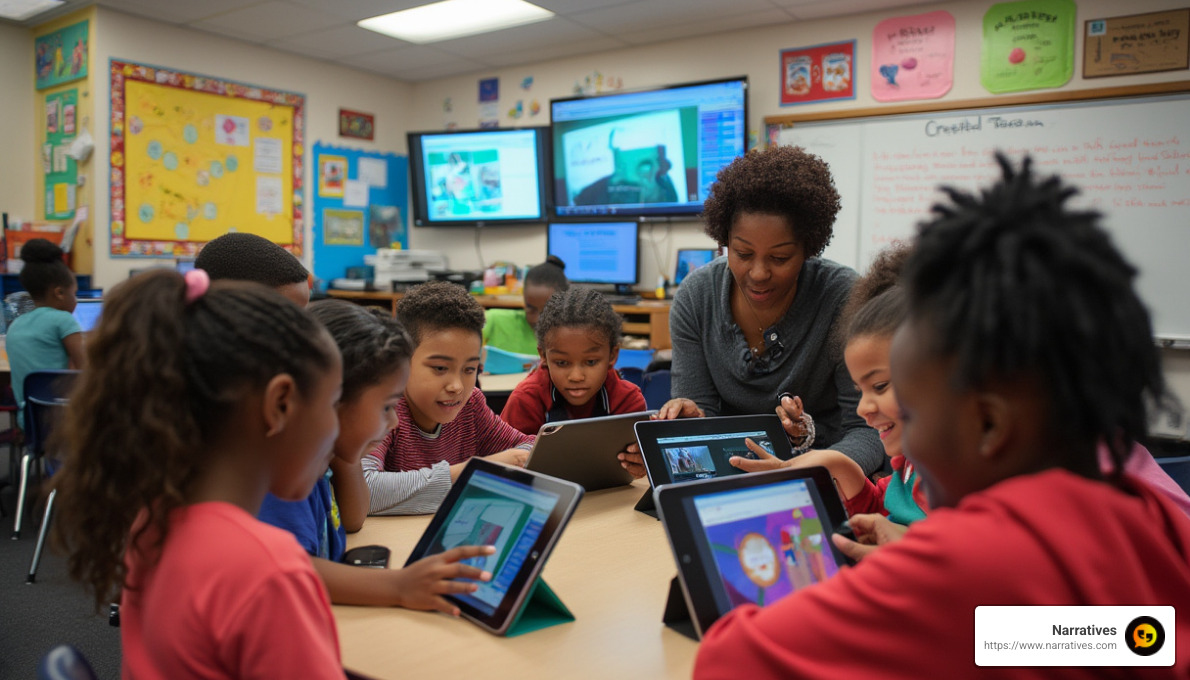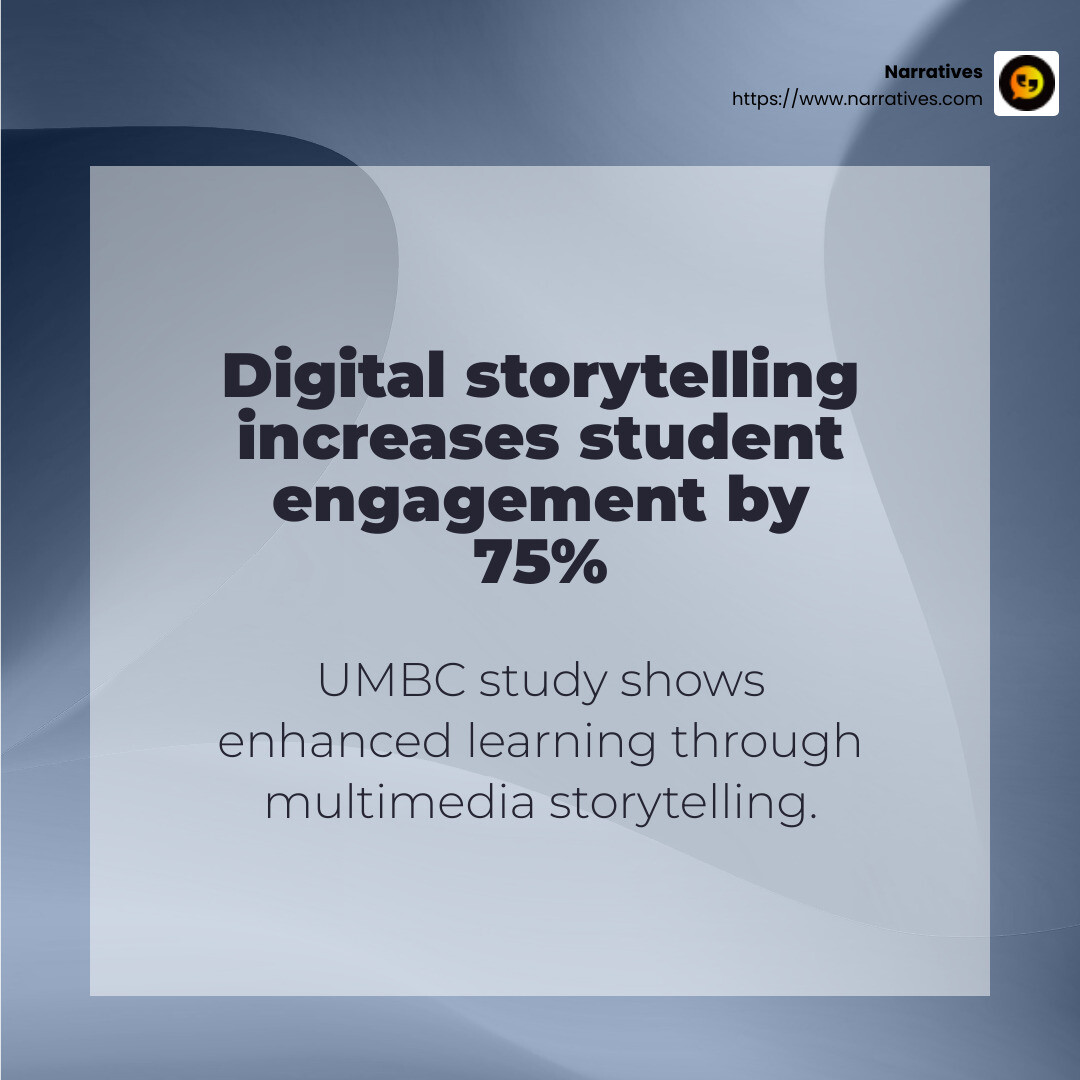Storytelling in the Digital Age: Educational Examples to Inspire

Examples of digital storytelling in education are changing classrooms into vibrant hubs of creative expression and learning. Right at the heart of this movement are digital stories, which blend traditional narrative with innovative technology to captivate students and educators alike.
Here are some noteworthy examples:
- Wixie: This tool makes it simple for young learners to craft and publish their stories, encouraging both creativity and literacy.
- UMBC Projects: From climate action to cultural history, these projects demonstrate the powerful impact of digital storytelling on educational outcomes.
- Interactive Campus Tours: As used by NHL University, these tours provide prospective students with an engaging, digital glimpse of campus life.
- Ikea Kreative: While not purely educational, this platform exemplifies digital storytelling by aligning home design with creative learning.
In today's rapidly evolving digital landscape, storytelling is no longer limited to just words on a page. It's about leveraging multimedia elements—like images, sound, and interactive components—to engage and inspire learners across all levels. Through digital storytelling, students have the chance to explore complex topics in a way that's both accessible and engaging, ultimately paving the way for a more connected and empathetic world.

Examples of digital storytelling in education terms you need:
- digital storytelling guide for educators
- interactive digital storytelling examples
- why is digital storytelling an effective learning tool
The Power of Digital Storytelling in Education
Digital storytelling is revolutionizing education by making learning more engaging and impactful. It combines the timeless art of storytelling with modern technology to influence, teach, and inspire students.
Engagement is at the core of digital storytelling. By using multimedia tools like videos, audio, and interactive elements, educators can capture students' attention more effectively than traditional methods. A study by UMBC highlights this, showing how digital stories can transform dry subjects into compelling narratives that resonate with students.

Influence is another powerful aspect. Stories can influence students' perceptions and attitudes, making them more open to new ideas. For example, UMBC's "Communications, Climate, Composting" project used video to raise awareness about environmental issues, influencing students to adopt more sustainable practices.
Teaching through digital storytelling allows educators to present information in a relatable and memorable way. Instead of static lectures, students experience dynamic stories that illustrate concepts vividly. This method not only improves understanding but also retention.
Finally, inspiration plays a crucial role. Digital storytelling inspires students by showing them real-world applications of what they learn. Projects like UMBC's "A Place Called Poppleton" document cultural history, inspiring students to appreciate and preserve their own communities' stories.
Digital storytelling is more than just a teaching tool. It's a way to engage, influence, teach, and inspire students, making education a more enriching experience. This approach not only benefits students but also empowers educators to connect with their classes on a deeper level.
Examples of Digital Storytelling in Education
Digital storytelling is reshaping education, offering fresh ways to engage students and communities. Let's explore some examples of digital storytelling in education, focusing on impactful projects from UMBC.
UMBC Projects: A Hub for Innovation
UMBC has been at the forefront of integrating digital storytelling into education. The university's projects often blend community leadership, climate action, and digital media to create meaningful narratives that resonate with diverse audiences.
Community Leadership and Engagement
One standout project is the Community Leadership Digital Storytelling Class 2023. This initiative brought together students and community members for a three-day intensive workshop. Participants crafted digital stories that highlighted local issues, fostering a sense of community engagement and leadership. This hands-on approach not only taught storytelling techniques but also empowered participants to become change-makers in their communities.
Climate Action through Storytelling
The Communications, Climate, Composting project is another exemplary case. Students collaborated with the UMBC Climate Action Steering Committee to produce videos addressing environmental challenges in Baltimore. This project used digital storytelling to raise awareness and inspire action on climate change, demonstrating how storytelling can be a powerful tool for advocacy and education.
Digital Media and Cultural History
In the project A Place Called Poppleton, UMBC students created a digital walking tour documenting the cultural history of Southwest Baltimore's Poppleton neighborhood. By using digital media, students were able to preserve and share the rich stories of the area, highlighting the importance of cultural heritage and community identity.
Global Collaboration in Times of Crisis
Global Voices in a Time of Pandemic was a collaborative effort between UMBC and Hong Kong University. Students from both institutions shared digital stories about their experiences during the pandemic. This project emphasized the power of storytelling to connect people across borders, offering diverse perspectives on a global crisis.
Reflection and Service through Digital Stories
The Shriver Peaceworker Program encourages students to reflect on their service experiences through digital storytelling. Since 2009, participants have created over 70 digital stories, capturing their journeys and the impact of their work. This project highlights how storytelling can be used for personal reflection and to inspire others to engage in service.
These UMBC projects illustrate the transformative potential of digital storytelling in education. By using the power of narrative and technology, educators can create engaging, impactful learning experiences that extend beyond the classroom.
Top 5 Educational Digital Storytelling Projects
Community Leadership Digital Storytelling Class 2023
One of the standout initiatives at UMBC is the Community Leadership Digital Storytelling Class 2023. This project brought together students and community members for a dynamic three-day workshop. Here, participants crafted digital stories that highlighted pressing local issues. This hands-on experience not only taught storytelling techniques but also empowered individuals to become community leaders and agents of change. By fostering community engagement, the project showcased how digital storytelling can actively contribute to local development and leadership.
Communications, Climate, Composting: A Video Project
The Communications, Climate, Composting project is a remarkable example of using digital storytelling for climate action. Students collaborated with the UMBC Climate Action Steering Committee to produce engaging videos that addressed environmental challenges in Baltimore. This initiative demonstrated the power of digital storytelling to raise awareness and inspire action on climate change. By creatively combining communication strategies with environmental themes, the project highlighted the role of storytelling as a tool for advocacy and education.
A Place Called Poppleton
In the project A Place Called Poppleton, UMBC students started on a journey to capture the cultural history of Southwest Baltimore's Poppleton neighborhood. They created a digital walking tour that documented the area's rich stories and cultural heritage. Through digital media, students were able to preserve and share these narratives, emphasizing the importance of cultural identity and community history. This project illustrated how digital storytelling can be used to connect past and present, fostering a deeper understanding of cultural heritage.
Global Voices in a Time of Pandemic
Global Voices in a Time of Pandemic was a collaborative effort between UMBC and Hong Kong University. Students from both institutions exchanged digital stories about their experiences during the pandemic. This cross-border project highlighted the power of storytelling to connect people globally, offering diverse perspectives on a shared crisis. By sharing personal narratives, the initiative underscored how digital storytelling can foster empathy and understanding in times of global challenges.
Shriver Peaceworker Program
The Shriver Peaceworker Program at UMBC encourages students to reflect on their service experiences through digital storytelling. Since 2009, participants have created over 70 digital stories, capturing their journeys and the impact of their work. This project showcases how storytelling can be a powerful tool for personal reflection and community inspiration. By sharing their service experiences, students not only reflect on their own growth but also inspire others to engage in meaningful service.
These UMBC projects illustrate the transformative potential of digital storytelling in education. By using the power of narrative and technology, educators can create engaging, impactful learning experiences that extend beyond the classroom.
Benefits of Digital Storytelling in Education
Digital storytelling in education offers numerous benefits, changing how students learn and engage with content. Here are some key advantages:
Empathy and Diverse Perspectives
Digital storytelling fosters empathy by allowing students to step into different shoes and see the world from various angles. Projects like Global Voices in a Time of Pandemic illustrate how storytelling connects students across borders, providing diverse perspectives on shared experiences. Through these narratives, students learn to understand and feel what others are going through, broadening their worldview and enhancing their capacity for empathy.
Engagement Through Multimedia Tools
Incorporating multimedia tools—such as video, audio, images, and text—makes learning more interactive and engaging. The Communications, Climate, Composting project at UMBC showed how students used video to address environmental issues. By blending different media, students can convey complex ideas in a more relatable and dynamic way, keeping their audience engaged and interested.
Encouraging Active Participation
Digital storytelling encourages students to actively participate in their learning journey. In the Community Leadership Digital Storytelling Class 2023, students didn't just learn about storytelling; they became storytellers. This hands-on approach empowers students, turning them into creators who can explore topics deeply and share their insights with others.
Enhancing Cultural Understanding
Projects like A Place Called Poppleton highlight how digital storytelling can preserve and share cultural stories, fostering a deeper appreciation for cultural identity and history. By documenting and sharing these narratives, students connect past and present, gaining a richer understanding of their own and others' cultural heritage.
Building Critical Skills
Digital storytelling helps students develop critical skills such as communication, creativity, and critical thinking. As students craft their stories, they learn to organize their thoughts, express ideas clearly, and use technology effectively. These skills are invaluable in today's digital age, preparing students for future academic and professional challenges.
By embracing digital storytelling, educators can create a more engaging and inclusive learning environment. It's not just about telling stories—it's about connecting, understanding, and inspiring.
How to Implement Digital Storytelling in the Classroom
Implementing digital storytelling in the classroom can transform the learning experience. Here's how educators can get started with interactive elements, multimedia, and storytelling techniques.
Use Interactive Elements
Interactive elements make stories more engaging and memorable. Consider adding:
- Clickable links: Direct students to additional resources or related content.
- Quizzes and polls: Engage students by testing their understanding or gathering opinions.
- Animations and gamification: Use simple animations or game-like elements to bring stories to life.
For example, Schiphol Airport's use of QR codes and mini-games shows how interactivity can improve user engagement. Students can create similar interactive experiences in their projects, making learning more dynamic and fun.
Leverage Multimedia
Multimedia is key to effective digital storytelling. Combining text, images, audio, and video can help students convey their messages more powerfully. Here's how to incorporate multimedia:
- Video and audio: Encourage students to record themselves narrating their stories or create short videos to illustrate their points. Projects like the Communications, Climate, Composting video project at UMBC demonstrate the impact of using video to address complex topics.
- Images and graphics: Use visuals to support the narrative. High-quality images can make stories more appealing and help convey emotions and themes effectively.
Employ Storytelling Techniques
Understanding and using storytelling techniques can greatly improve student projects. Some techniques to consider:
- The Hero's Journey: A classic structure that involves a main character overcoming challenges. This technique can help students organize their stories and engage their audience.
- Descriptive language: Encourage students to use vivid descriptions to evoke emotions and create a deeper connection with the audience.
- Clear message and purpose: Ensure students have a clear understanding of the message they want to convey and why it's important. This clarity will guide their storytelling process.
By integrating these elements, teachers can help students craft compelling digital stories that are both educational and engaging. This approach not only improves students' storytelling abilities but also prepares them for a world where digital literacy is increasingly important.
Frequently Asked Questions about Digital Storytelling in Education
What are the benefits of digital storytelling in education?
Digital storytelling offers a myriad of benefits in the educational landscape. It improves engagement by capturing students' interest through dynamic and interactive content. When students are engaged, they are more likely to retain information.
Moreover, digital storytelling fosters creativity. By allowing students to express themselves through various media—such as video, audio, and images—they can explore new ways of thinking and communicating.
Empathy is another key benefit. Storytelling encourages students to view situations from different perspectives, helping them understand and connect with diverse experiences. This is supported by research that shows storytelling releases oxytocin, a hormone associated with empathy and connection.
How can digital storytelling be used to teach empathy?
Teaching empathy through digital storytelling involves encouraging students to explore and share stories from perspectives different from their own. This practice helps them understand and appreciate diverse backgrounds and experiences.
One effective approach is to have students create stories based on characters from literature or real-life scenarios that differ from their own identities. For example, students might rewrite a moment from a piece of literature, considering how a different character might perceive the situation.
Projects like UMBC's Community Leadership Digital Storytelling Class offer practical examples. Students collaborate with community members to create stories that highlight local issues, fostering a deeper understanding and empathy for their community.
What tools are available for digital storytelling in education?
There are numerous tools available to help educators and students create compelling digital stories. Some popular options include:
- Video editing software: Tools like Adobe Premiere Pro or iMovie allow students to edit and produce high-quality videos.
- Audio recording apps: Applications such as Audacity or GarageBand are excellent for recording and editing audio segments.
- Presentation software: Platforms like Microsoft PowerPoint or Google Slides can be used to create multimedia presentations.
- Interactive platforms: Tools like Wixie's Mind Map or StoryMapJS enable students to create interactive and engaging stories.
These tools empower students to express their ideas creatively and effectively, making learning both fun and impactful. By integrating these resources, educators can support students in crafting digital stories that are rich in content and meaningful in context.
Conclusion
In today's digital world, Narratives stands out as a guide for non-profits and purpose-driven organizations seeking to harness the power of storytelling. Our focus on non-profit partnerships allows us to lift voices that often go unheard, ensuring that impactful stories reach broader audiences.
Digital storytelling isn't just about sharing stories—it's about creating social impact. By collaborating with non-profits, we help them articulate their missions and successes in a way that resonates emotionally with their audience. This approach builds trust and increases visibility, crucial elements for any organization aiming to make a difference.
Community-driven storytelling is at the heart of what we do. We work closely with communities to craft narratives that reflect their unique experiences and challenges. This not only empowers the communities but also inspires action from those who engage with these stories.
By choosing Narratives as your digital storytelling partner, you align with a mission to drive change through authentic and compelling content. Our commitment to elevating underrepresented voices ensures that every story told has the potential to inspire and influence.
Explore how we can help your organization share its impact stories effectively by visiting our service page. Together, let's create stories that matter.


